
|
 |
 |
 |
 |
 |
| Author |
Message |
    
Neal Shelden
Sergeant
Username: Neal
Post Number: 43
Registered: 3-2003
| | Posted on Saturday, April 26, 2003 - 5:15 pm: |       |
In 1899 Southwark Police Station opened its doors to a newly-promoted officer from the East End: Inspector George Godley....writes Debra Gosling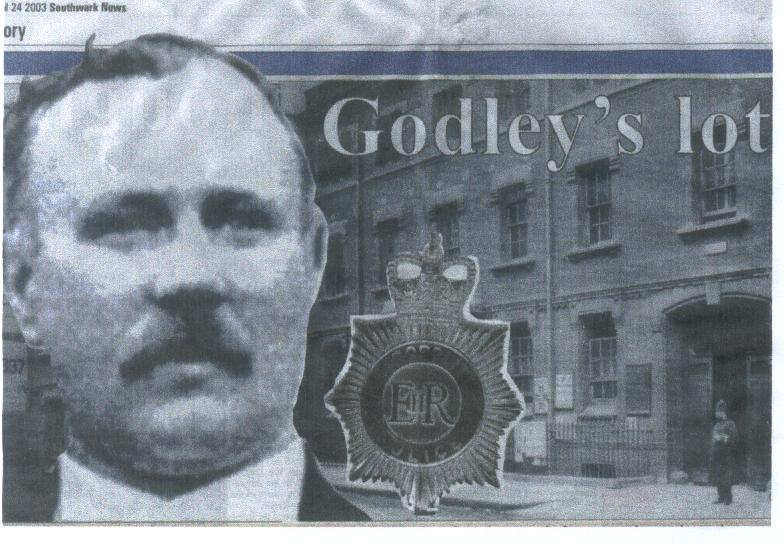 |
    
Neal Shelden
Sergeant
Username: Neal
Post Number: 44
Registered: 3-2003
| | Posted on Saturday, April 26, 2003 - 5:19 pm: |       |
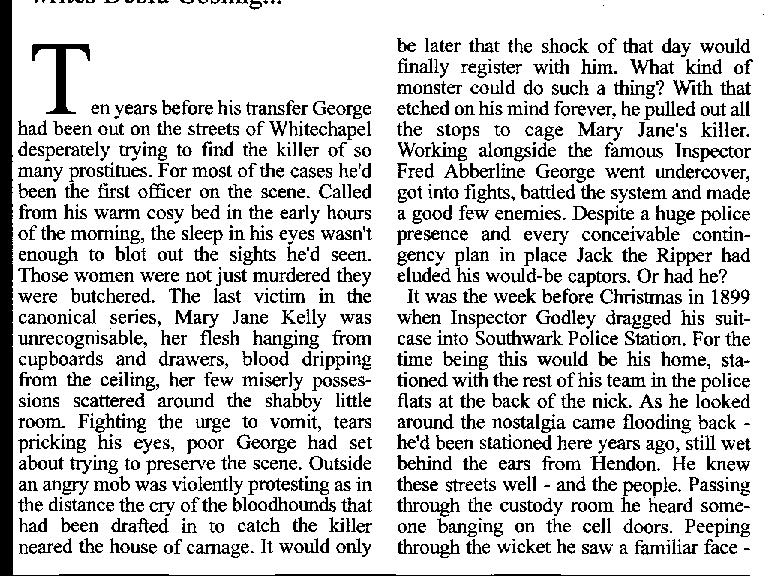 |
    
Neal Shelden
Sergeant
Username: Neal
Post Number: 45
Registered: 3-2003
| | Posted on Saturday, April 26, 2003 - 5:38 pm: |       |
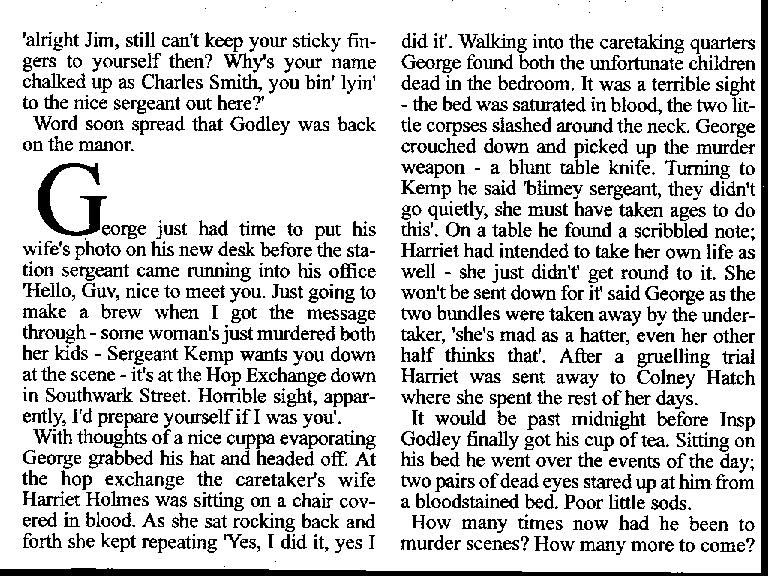 |
    
Neal Shelden
Sergeant
Username: Neal
Post Number: 46
Registered: 3-2003
| | Posted on Saturday, April 26, 2003 - 5:56 pm: |       |
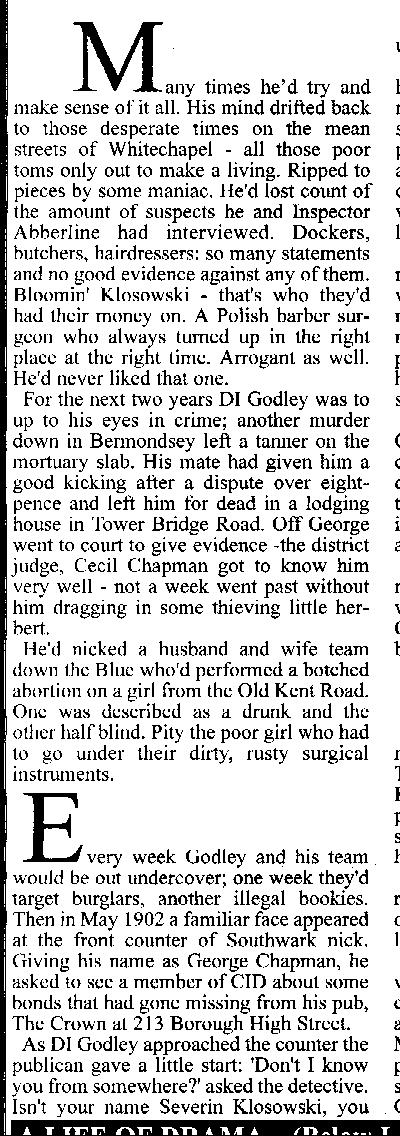 |
    
Neal Shelden
Sergeant
Username: Neal
Post Number: 47
Registered: 3-2003
| | Posted on Saturday, April 26, 2003 - 6:03 pm: |       |
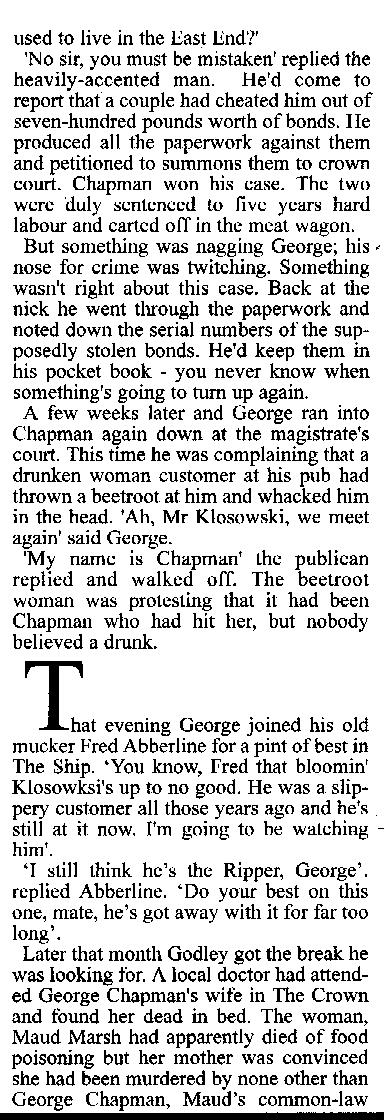 |
    
Neal Shelden
Sergeant
Username: Neal
Post Number: 48
Registered: 3-2003
| | Posted on Saturday, April 26, 2003 - 6:09 pm: |       |
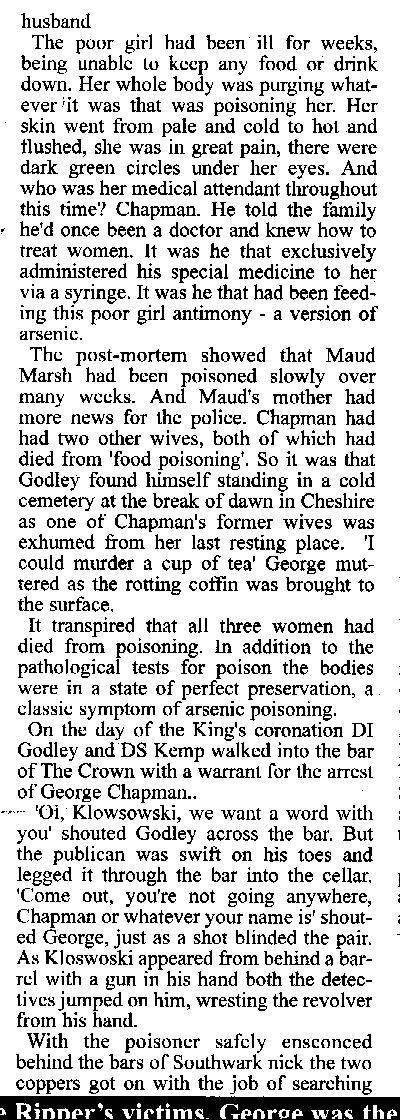 |
    
Neal Shelden
Sergeant
Username: Neal
Post Number: 49
Registered: 3-2003
| | Posted on Saturday, April 26, 2003 - 6:23 pm: |       |
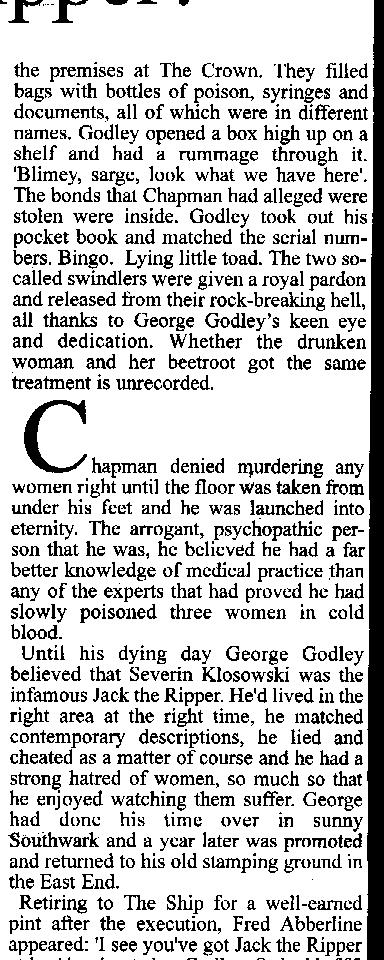 |
    
Neal Shelden
Sergeant
Username: Neal
Post Number: 50
Registered: 3-2003
| | Posted on Saturday, April 26, 2003 - 6:31 pm: |       |
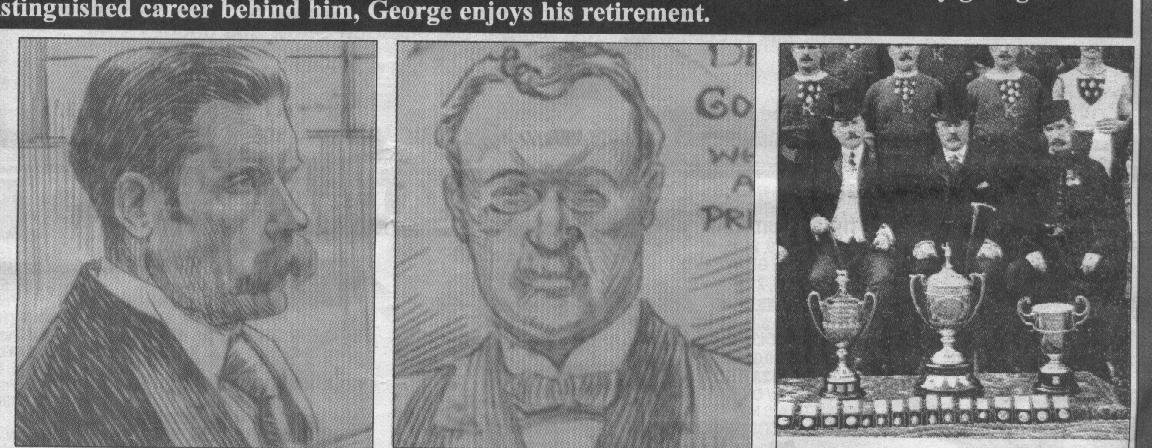
Debra Gosling did some research for R.Michael Gordon's book on JTR. |
    
Saddam Hussein The Dictator
Unregistered guest
| | Posted on Sunday, April 27, 2003 - 1:56 pm: |       |
Neal,
Thanks for posting the above. May I ask about the police badge shown in the first photograph? What would have been its true colors? It's got three basic areas--the outer metal part which I think would have been silver, an outer circle and an inner circle. What were the original colors of each area? What color was the lettering? What did the letters ER signify? Thanks so much for your help.
Saddam |
    
Jeffrey Bloomfied
Sergeant
Username: Mayerling
Post Number: 31
Registered: 2-2003
| | Posted on Sunday, April 27, 2003 - 9:41 pm: |       |
Interesting point about the scene of Chapman's
arrest in 1902 - that he had a gun. I find it
funny that people who argue about a poisoner
being suspected of cutting up women (despite the
fact the poisoner was a medical assistant), because poisoners usually just stick to poison,
fail to note this one liked to have a gun - if
he did, he could have liked to have a knife too.
The story of the arrest, trial, and execution
of Chapman is also given in Chief Inspector Arthur
Fowler Neil's memoirs, MAN-HUNTERS OF SCOTLAND
YARD (Garden City, New York: Sun-Dial Press, 1932,
1935, 1938), pp. 1-16. He gives another, slightly
different view of the business of Chapman and
his gun. It is on pages 7 - 8. Keep in mind,
the police were shadowing Chapman's bar/house for
a few days prior to arresting him for suspicion
of murdering his wife, Maud Marsh. He appears to
have been aware of this, and was planning to flee,
but delayed (fatally, as it turned out) because
the procession for the coronation of King Edward
VII was going to pass his bar, and it would mean
great business. [Edward was supposed to have his
coronation earlier in the year, but it was postponed due to illness, and rescheduled for
October 25, 1902.]
"In those days opening-time in the Borough was
at five - thirty in the morning. At about nine
- thirty my Chief [Inspector Godley], accompanied
by Sergeant Kemp and another colleague, both of
whom are gone, went into the bar. Chapman was
behind the counter. With a slight nod Godley
beckoned him towards them.
As he shuffled across the floor his great
shining black eyes -- eyes that had lured so many
women to their deaths -- looked as if they had just seen a vision of the gallows. Under his thick mop of coal-black hair his face was livid,
and the black moustache was powerless to conceal
the workings of his mouth, which, according to
Kemp's description, kept opening and shutting like that of a fish.
"I wish to speak to you in private, Mr. Chapman," said Godley.
"What about?" demanded the murderer, fencing
desperately for time. But he knew quite well they had come to get him.
"I would rather discuss it somewhere else,"
said Godley. "It is too important to talk about
in the public bar."
Without a word Chapman led the way to a nearby billiards-room. The door was shut and they closed round him.
"We are detectives," said my Chief. "Maud
Marsh, who has been living with you as your wife,
has been poisoned. Owing to the circumstances
of her death it is my duty to take you to the police station while I make enquiries into the
matter."
For a moment Chapman made no reply. His eyes
went from one to another of them. He was armed --
a loaded revolver was found in his pocket when he
was searched at the station, and the thought of
making a fight for it probably flashed across his
mind. But he must have thought better of it, and
besides there were people in the bar. He could not get away, and resistance would have been
equivalent to a confession of guilt.
"I know nothing about this thing," he said at
length. "I do not know how she got the poison."
"Very well, you must come with us," said
Godley.
As they left with their prisoner between them, the people were already gathering in th streets to wait for the Royal procession, and they
had to push through dense but good-natured crowds."
Neil does not mention the gun being fired, as
in the newspaper article. I suspect that the
reporter added that for excitement or color to the
account.
I found out a number of years ago that Chapman may have met a future celebrity (or so the
celebrity maintained in his memoirs). About the
time Maud was dying upstairs, a young street boy
came into the bar and asked Chapman for a drink of
water. Chapman gave him a glass, but the boy felt
something wrong (so he claimed in his memoirs) about the atmosphere of the bar and it's owner.
He pretended to drink some of the water, and then
went out. That, at least is what Charles Spencer
Chaplin says in his autobiography.
Jeff
|
    
Debra Gosling
Unregistered guest
| | Posted on Monday, October 27, 2003 - 3:04 pm: |       |
Hi there
I'm the person that wrote the Southwark News article - I've only just seen it and I'd just like to answer a couple of questions.
Re: the gun firing - I got the information from the Southwark and Bermondsey Recorder and from the Police Review - May 15 1908. I think the story was juicy enough without adding to it!
With regards to the police badge on the picture - it really shouldn't have been there - that was my editor thinking it would enhance the piece when all it did was obscure the picture of Southwark Police Station. For the record it is a modern-day Met Police badge with a blue enamel circle. The original badge that George would have sported would have been just silver (I think).
Thanks for reading my bit on the Met's finest officer.
Debra |
    
R Lingwood
Unregistered guest
| | Posted on Monday, December 22, 2003 - 6:26 am: |       |
Hello.
not sure if anyone is still following this thread but Arthur Fowler Neil's memoirs are also published under the title of 'Forty Years Of Man-hunting' ,published by Jarrolds.
Can't recommend it enough , a riveting read (though I'm a bit biased as he was my Grandmothers Uncle) |
    
scarlotti
Unregistered guest
| | Posted on Tuesday, December 23, 2003 - 7:31 pm: |       |
ER should signify Elizabeth Regina - i.e. the Head of State in the
Uk.
But from 1899 - surely a police badge should have borne
the inscription VR? (i.e Victoria) |
|
Use of these
message boards implies agreement and consent to our Terms of Use.
The views expressed here in no way reflect the views of the owners and
operators of Casebook: Jack the Ripper.
Our old message board content (45,000+ messages) is no longer available online, but a complete archive
is available on the Casebook At Home Edition, for 19.99 (US) plus shipping.
The "At Home" Edition works just like the real web site, but with absolutely no advertisements.
You can browse it anywhere - in the car, on the plane, on your front porch - without ever needing to hook up to
an internet connection. Click here to buy the Casebook At Home Edition.

|
 |
 |
|







